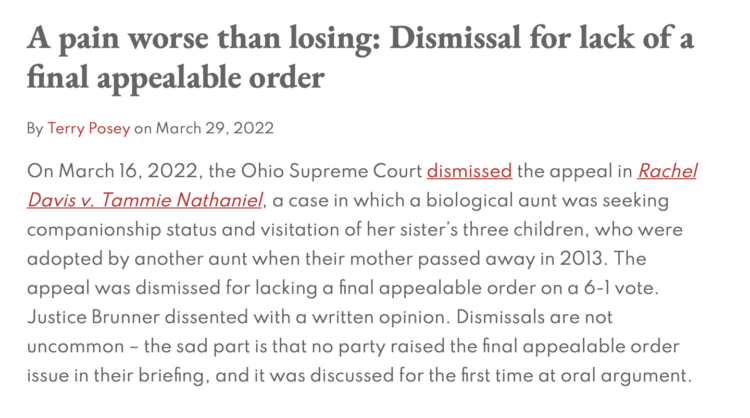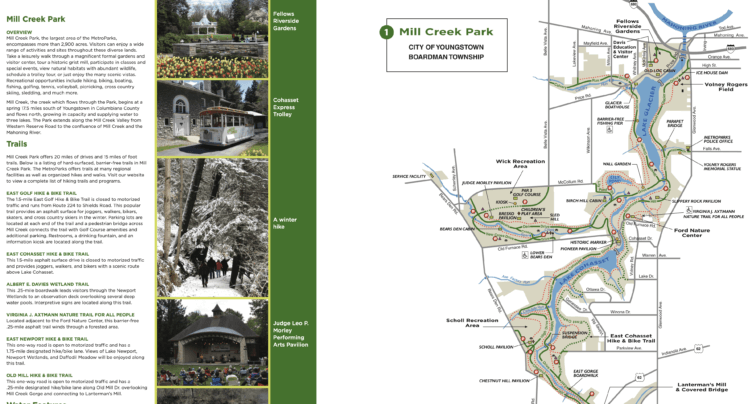SCHLEGEL v. SWEENEY– the Bike Trail Appropriation case – was released by the Ohio Supreme Court this morning… and… it’s complicated… and … it’s not over… and it’s subject to more litigation… and more appeals… but, as of today, the Park District gets to move forward in its bid to acquire land for a bike trail in Mahoning County.
I’ve written about this case in the past… it’s… complicated… but the bottom line, as of today’s very rare 7-0 Ohio Supreme Court decision, is that the “appropriation case” filed by the Mill Creek Metropolitan Park District against a land owner to acquire property to build a bike trail may progress. The case is not over, however, and provides some lessons in power & tenacity.
“Appropriation” is a means for government entities to take property from private citizens for government purposes. Based on the power of “eminent domain,” this allows the government to obtain private property it needs for public projects and requires the government to pay Fair Market Value for the property. For example, let’s say the government wants to widen a road, add lanes … and it doesn’t have enough room to do that… it can try to negotiate a deal with all the landowners to buy enough land…or it can file an appropriation action to take it.
You may think this is crazy- the government taking your property…but… This power of eminent domain is found in both the Ohio Constitution and the US Constitution.
Wait, say WHAT?
Yep and the place where it is found is somewhat surprising… You know that 5th Amendment we hear so much about? Miranda Warnings… Taking the 5th… the right of someone charged with a crime to not be forced to talk? Well, if you read the ENTIRE 5th Amendment it does on to say “…nor shall private property be taken for public use, without just compensation….”
The writers of the Constitution were not going to allow the government to simply TAKE your property – it could only be taken for a “public use” and the government has to pay “just compensation.”
The Ohio Constitution is similar: “Private property shall ever be held inviolate, but subservient to the public welfare.”
The Ohio Constitution talks about “public roads” but has a more general catch-all clause that applies “…in all other cases, where private property shall be taken for public use, a compensation therefor shall first be made in money, or first secured by a deposit of money; and such compensation shall be assessed by a jury, without deduction for benefits to any property of the owner.”
So, bottom line, the government can take your property for public use- but has to pay fair/just compensation to you.

In some cases “public use” becomes a big issue. A while back in the Cincinnati suburb of Norwood, Ohio eminent domain was used to try to take property to allow for commercial development. Norwood tried to take about 70 homes. Everyone sold, often for values that far exceeded the auditor’s value, except for a couple owners. The city bulldozed all the others and fought the holdouts up to the Ohio Supreme Court. The Court held, in 2006, that the land owners WON – the court held that “…while economic factors may be considered in determining whether governments can take private property, the economic benefit to the government and community cannot be the only justification used for seizure.”

In Mahoning County, near Youngstown, The Mill Creek Park folks wanted land for a bike trail. It filed an appropriation lawsuit in 2019 to get some land from Mr. Schlegel. The bike trail clearly met the Public Use prong of the Eminent Domain rulings.
The problem was that Mr. Schlegel did not want to sell his land to the government. While the case was pending some local folks were able to use their political clout to get the Ohio legislature to pass a law that says, in essence: “…no park district “located in a county with not less than 220,000 and not more than 240,000 residents” can use its eminent domain power to acquire property for a recreational trail….” SO the legislature said of the 88 counties in Ohio, all the counties with more than 240,000 people and all the counties with less than 220,000 people could use eminent domain to take property for a bike trail… but in those counties in the 220,000 – 240,000 population range, they could not…
Hmmmm… that sounds oddly… specific… and indeed it was not just oddly specific, it was intentionally specific. IT was aimed at stopping the Mill Creek lawsuit.
There are only a couple counties to which this law would apply. Delaware County jumped into the 220K+ group. Lake County is there and Warren County was in the group but is moving up after the last census & is out of the 220-240K population group. So 85 counties were NOT bound by the law, and 3 were? Again, an oddly partisan result.

Once they got the new law passed, the defendants filed for a “writ of prohibition” from the Ohio Supreme Court. This is an order that says the trial court was simply prohibited by law from hearing the case.
For example, if a state trial court in Ohio tried to handle a Bankruptcy case it would be subject to a writ of prohibition since bankruptcy proceedings can only go forward in a federal bankruptcy court.
Here, the defendant argued that since the new law clearly captured the precise situation…as it was designed to do… he should be permitted stop the appropriation case dead in its tracks because the court had no jurisdiction to hear the case.
The case gets complicated here… oh wait, you thought it was already complicated?
The law of Ohio says you can only appeal a case [well, most cases…again, it’s complicated] when the case is “over.” In Ohio there is a long history of case law defining when a case is over. That’s seems odd, eh? When is a case over? You’d think it would be easy and obvious, but it is not. In fact, there is an entire body of case law on FAO’s… Final Appealable Orders… what has to be in an order to make it an order that a party can appeal from.
In my very first law gig as a law clerk to an appellate judge [The Most Very Honorable Richard N. Koehler… Judge K was da BOMB!!], my 1st task in every case we received was to track the procedural history, read all the orders and make sure the order appealed from was actually a FAO. If it was NOT a FAO then we had no jurisdiction to hear the appeal and had to send the case back to the trial court. We often found that when we had lawyers with limited appellate experience handling a case with some complexity we stood a pretty good chance of figuring out that there was NO FAO…
Losing your appeal for lack of a Final Appealable Order is… painful… I’m sure… I’ve never had that happen- one of the benefits of working as an appellate law clerk early in your career is that you realize that you start planning for an appeal on DAY ONE – the 1st day you meet a potential client! One appellate commentator expressed it like this:

Why is having a Final Appealable Order important in THIS case though since the writ of prohibition is one of the VERY few legal tools that is actually FILED originally in the Ohio Supreme Court? There is no “FAO” because nothing is being appealed… it’s a brand new shiny case… except…
… in order for the land owner to short circuit the appropriation case and win a writ of prohibition he had to show that he had no adequate “legal remedy”– i.e., that the appropriation case was “over” and that his appeal time had run out.
[Now if that were actually true – that he had lost & he had not appealed- then he might have a good legal malpractice case against his lawyer…but I digress…]
A writ of prohibition is a very cool tool, IF you can meet the test. Why? Because you file it directly in the Supreme Court – and if you win the writ the case you are aiming at, the case you are trying to stop, is just stopped cold and is “prohibited” from moving forward [oh, I see what you did there]. However, many are filed – Few are won…
Here, the Court looked to see if the case was over… to see if the land owner had any sort of “legal remedy” left in the appropriation case. The owner argued that his appeal time had run out, but the court said NOPE.
The trial court had ordered that the new law did not apply to the case. The court ordered that the land was ripe for appropriation. However, there was never a trial or determination of how much the land owner would get. Before they got to the trial the land owner filed seeking the writ of prohibition. The Court cited a long line of cases holding that the land owner could appeal the entire case AFTER the jury told him how much he would get for his land… he could appeal arguing the amount was not enough. He could ALSO appeal arguing that the newly passed law should have been applied to his case.
So…bottom line… Mill Creek Park District gets to move forward and have a trial – Mr. Landowner can STILL appeal… and, with any luck, we’ll get a SECOND Ohio Supreme Court on all those issues around 2026…
The Mill Creek Park area is beautiful – I hope they eventually can push through the politics and WIN this case so the new trail can go forward…

Appropriation litigation [and appellate litigation] is not for the faint of heart, or for anyone who is without sufficient means to keep 10 years of litigation funded… and this case is a long way from over!
https://www.courtnewsohio.gov/cases/2022/SCO/1101/220025.asp#.Y2EiKS-B1qs
You can read the actual case here
https://www.supremecourt.ohio.gov/rod/docs/pdf/0/2022/2022-Ohio-3841.pdf
© 2024.